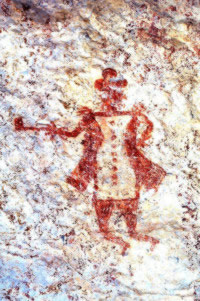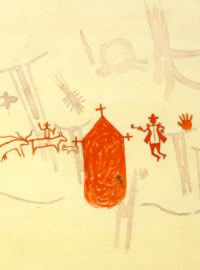Vaquero Shelter

Located in west-central Val Verde County, Seminole Canyon State Park is home to at least 15 distinct archeological sites containing rock art made by indigenous people. While most of these sites feature prehistoric rock art, one features pictographs that are undoubtedly historic in age. Known as Vaquero Shelter (41VV77), this site in Upper Presa Canyon contains images such as a church, a man in European clothing (a grandee, according to Lower Pecos archeologist Solveig Turpin), and cowboys (or vaqueros) lassoing a steer. According to reknown artist Forrest Kirkland, who painted a watercolor rendering of the panel, the subject appears so contemporary that it might have been the work of Anglo cowboys; however, the type and color of paint used on both the figures and the handprint argues for a Native artist.
Though the most prominent images at Vaquero Shelter date to the period of Spanish contact, they are painted over earlier figures done in what is known as Pecos River Style. This style of painting is the oldest known in the region and dates to between 2,700 and 1,400 B.C., indicating that the shelter was used by prehistoric groups long before the Spaniards arrived.
Vaquero Shelter is one of the better documented rock art sites in Texas, havin been investigated by Kirkland as well as pioneer Texas archeologist A.T. Jackson in the late 1930s. Continued documentation and photography of the paintings since that time has highlighted the immense toll inflicted upon the pictographs by the forces of nature. The hats worn by the riders, which were so apparent during the 1930s, are now imperceptible, faded by time and the elements.
The rock art sites of Seminole Canyon contain some of the oldest Indian art in North America as well as pictographs such as those at Vaquero Shelter which document the dynamic period of contact and conflict between European and indigenous groups. While groups such as the Rock Art Foundation are working to preserve these treasures, it is unclear how long these works of art will remain on the limestone walls.
Visitors can tour selected rock art sites in Seminole Canyon State Parks. See http://www.tpwd.state.tx.us/park/seminole/ for more information.

